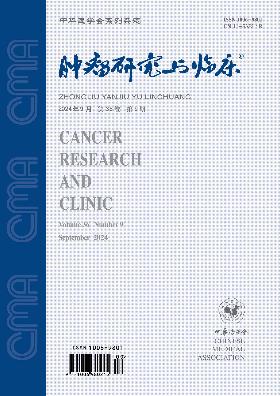癌症患者T3、T4淋巴结转移危险因素分析
Q4 Medicine
引用次数: 0
摘要
目的探讨癌症T3、T4淋巴结转移的危险因素,为临床诊断和治疗提供参考。方法回顾性分析2008年1月至2017年12月在西京消化病医院行结直肠癌癌症根治性切除术的1 112例T3、T4大肠癌患者的临床病理资料。分析淋巴结转移状况与临床病理因素及肿瘤标志物的相关性。采用logistic多元回归分析法分析淋巴结转移的相关危险因素。结果单因素分析显示,癌症患者淋巴结转移发生率按性别、年龄和肿瘤部位划分,差异无统计学意义(均P>0.05),不同肿瘤直径(<5cm和≥5cm)分别为37.75%(211/559)、52.26%(289/553)、,一般型[浸润、溃疡、阳伞、隆起:37.04%(20/54)、47.52%(432/909)、34.33%(23/67)、69.51%(57/82),χ2=13.787,P=0.003],分化程度[高分化、中分化、低分化:34.11%(102/299)、49.00%(317/647)、48.80%(81/166),χ0=19.771,P<0.01],错配修复缺陷(dMMR)[是与否:26.34%(64/243),50.17%(436/869),χ2=43.996,P<0.01],神经系统侵犯[是与非:48.17%(421/874),33.20%(79/238),χ0=16.954,P<0.01],血管侵犯[是和否:79.16%(338/427),23.65%(162/685),χ2=327.493,P<0.01]和术前癌胚抗原(CEA)[阳性(≥5 mg/ml)和阴性(<5 mg/ml):52.87%(249/471),39.16%(251/641),χ0=20.162,P<0.01],CA199[阳性(≤35 U/ml)和阴性0.01]具有统计学意义上述分层患者淋巴结转移发生率的差异。Logistic多元回归分析显示,术前CA199阳性和血管侵犯是结直肠癌患者T3、T4淋巴结转移的独立危险因素(OR=13.006,95%CI 9.329-17.276,P<0.01;OR=2.194,95%CI 1.513-3.181,P<0.01),dMMR阳性是淋巴结转移的保护因素(OR=0.279,95%CI 0.190-0.411,P<0.01)。术前肿瘤标志物CA199的检测可作为预测结直肠癌患者T3、T4淋巴结转移的指标。在一定程度上可以为结直肠癌患者T3、T4的诊断和治疗提供参考。关键词:结直肠肿瘤;淋巴结转移;风险因素本文章由计算机程序翻译,如有差异,请以英文原文为准。
Risk factors of lymph node metastasis in patients with colorectal cancer in T3 and T4
Objective
To investigate the risk factors of lymph node metastasis for patients with colorectal cancer in T3 and T4, and to provide a reference for clinical diagnosis and treatment.
Methods
The clinicopathological data of 1 112 patients with colorectal cancer in T3 and T4 who underwent radical resection of colorectal cancer in Xijing Digestive Disease Hospital from January 2008 to December 2017 were retrospectively analyzed. The correlation between lymph node metastasis status and the clinicopathological factors as well as tumor markers was analyzed. The related risk factors of lymph node metastasis were analyzed by using logistic multivariate regression analysis.
Results
Univariate analysis showed that there was no statistically significant difference in the incidence of lymph node metastasis among colorectal cancer patients stratified by gender, age and tumor location (all P > 0.05). The different tumor diameter [<5 cm and ≥5 cm: 37.75% (211/559), 52.26% (289/553), χ2 = 23.666, P < 0.01], general type [infiltration, ulcer, parasol, bulge: 37.04% (20/54), 47.52% (432/909), 34.33% (23/67), 69.51% (57/82), χ2 = 13.787, P = 0.003], degree of differentiation [highly-differentiated, moderately-differentiated, poorly-differentiated: 34.11% (102/299), 49.00% (317/647), 48.80% (81/166), χ2 = 19.771, P < 0.01], mismatch repair deficiency (dMMR) [yes and no: 26.34% (64/243), 50.17% (436/869), χ2 = 43.996, P < 0.01], neurological invasion [yes and no: 48.17% (421/874), 33.20% (79/238), χ2 = 16.954, P < 0.01], vascular invasion [yes and no: 79.16% (338/427), 23.65% (162/685), χ2 = 327.493, P < 0.01] and preoperative carcino-embryonic antigen (CEA) [positive (≥5 mg/ml) and negative (<5 mg/ml): 52.87% (249/471), 39.16% (251/641), χ2 = 20.162, P < 0.01] and CA199 [positive (≥35 U/ml) and negative (<35 U/ml): 59.33% (124/209), 41.64% (376/903), χ2 = 21.465, P < 0.01] had statistically significant differences in the incidence of lymph node metastasis for above stratified patients. Logistic multivariate regression analysis showed that vascular invasion and preoperative CA199-positive were independent risk factors for lymph node metastasis in patients with colorectal cancer in T3 and T4 (OR = 13.006, 95% CI 9.329-17.276, P < 0.01; OR = 2.194, 95% CI 1.513-3.181, P < 0.01), and dMMR-positive was a protective factor for lymph node metastasis (OR = 0.279, 95% CI 0.190-0.411, P < 0.01).
Conclusions
Vascular invasion is the main risk affecting factor for the lymph node metastasis of patients with colorectal cancer in T3 and T4. The detection of preoperative tumor marker CA199 can be used as an index to predict the lymph node metastasis of patients with colorectal cancer in T3 and T4. To a certain extent, it can provide a reference for the diagnosis and treatment of patients with colorectal cancer in T3 and T4.
Key words:
Colorectal neoplasms; Lymphatic metastasis; Risk factors
求助全文
通过发布文献求助,成功后即可免费获取论文全文。
去求助
来源期刊

肿瘤研究与临床
Medicine-Oncology
CiteScore
0.10
自引率
0.00%
发文量
7737
期刊介绍:
"Cancer Research and Clinic" is a series of magazines of the Chinese Medical Association under the supervision of the National Health Commission and sponsored by the Chinese Medical Association.
It mainly reflects scientific research results and academic trends in the field of malignant tumors. The main columns include monographs, guidelines and consensus, standards and norms, treatises, short treatises, survey reports, reviews, clinical pathology (case) discussions, case reports, etc. The readers are middle- and senior-level medical staff engaged in basic research and clinical work on malignant tumors.
 求助内容:
求助内容: 应助结果提醒方式:
应助结果提醒方式:


